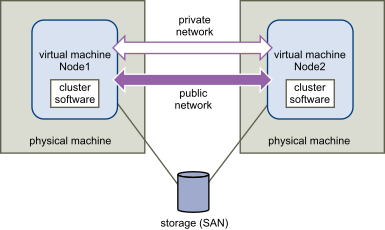A cluster of virtual machines across physical ESXi hosts (also known as a cluster across boxes or CAB) protects against software failures and hardware failures on the physical ESXi hosts by placing the cluster nodes on separate ESXi hosts. This configuration requires shared storage for the clustered disk resources.
The following figure shows a cluster-across-boxes setup.
- Two virtual machines on two different ESXi hosts run WSFC.
- The virtual machines share a private network connection for the private heartbeat and a public network connection.
- Each virtual machine is connected to shared storage.
- ESXi host supports up to 16 WSFC clusters (multi-cluster) running on the same ESXi host.
Note: In a cluster of virtual machines across physical hosts, shared disks can be physical mode or vVol with vSphere 6.7 or later. You can use VMFS VMDKs from SCSI SAN with vSphere 7.0 or later and from NVMe SAN with vSphere 8.0 or later. If you are using RDMs or vVol as shared disks, they can be on Fibre Channel (FC) SAN, FCoE or iSCSI. If you are using VMFS VMDKs as shared disks, they can be on FC SAN. vSphere 8.0 U3 or later vVol will also support shared disk from NVMe storage arrays ( FC, TCP). vSphere 8.0 U3 or later VMFS VMDKs will also support storage from NVMe TCP array.

Note: Windows Server 2012 and above systems support up to five nodes (virtual machines). For supported guest operating systems see
Other Clustering Requirements and Recommendations.
Note: Private and Public network interconnect can share a single virtual NIC in a VM.
You can expand the cluster-across-boxes model and place multiple virtual machines on multiple ESXi hosts.